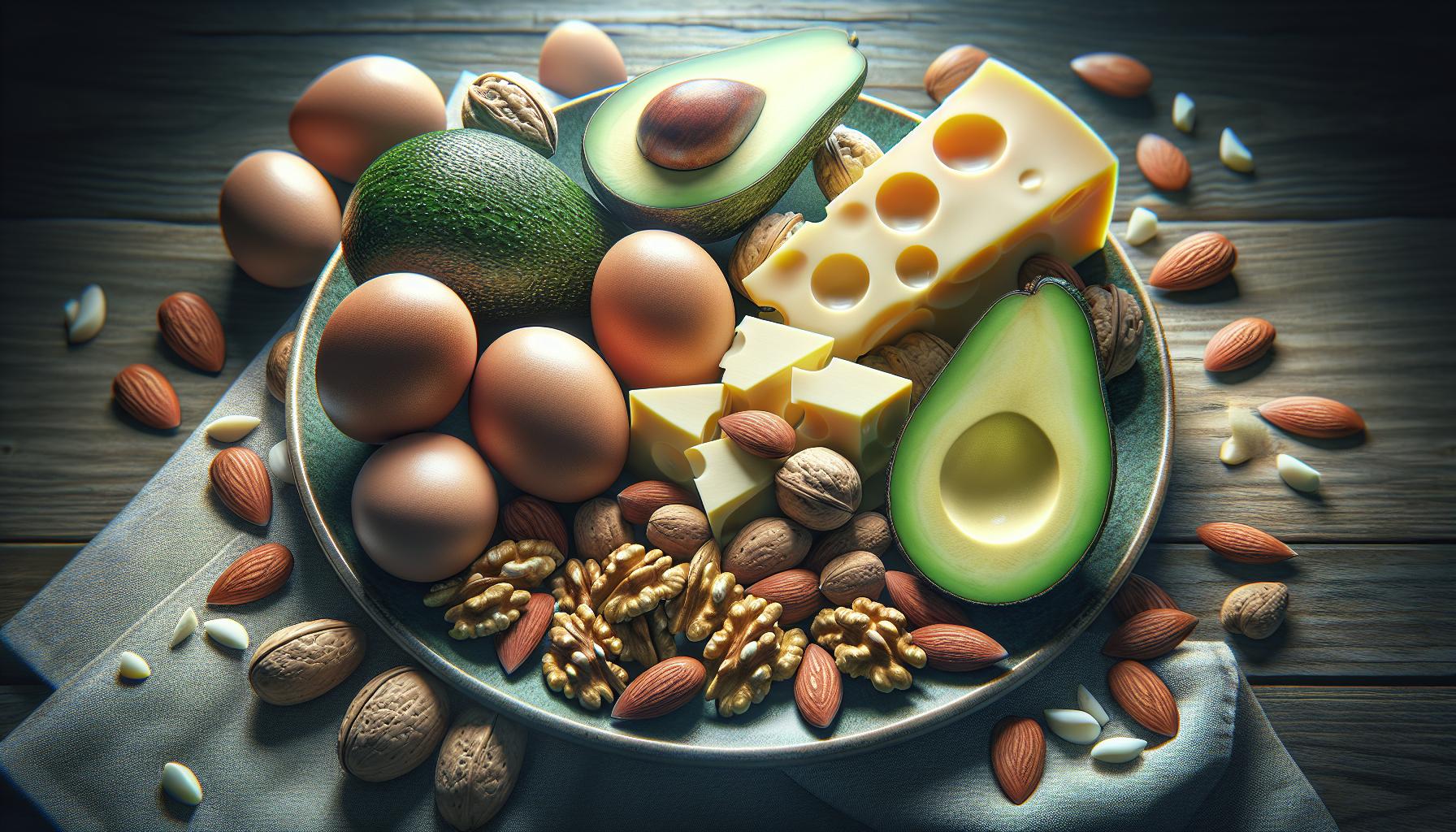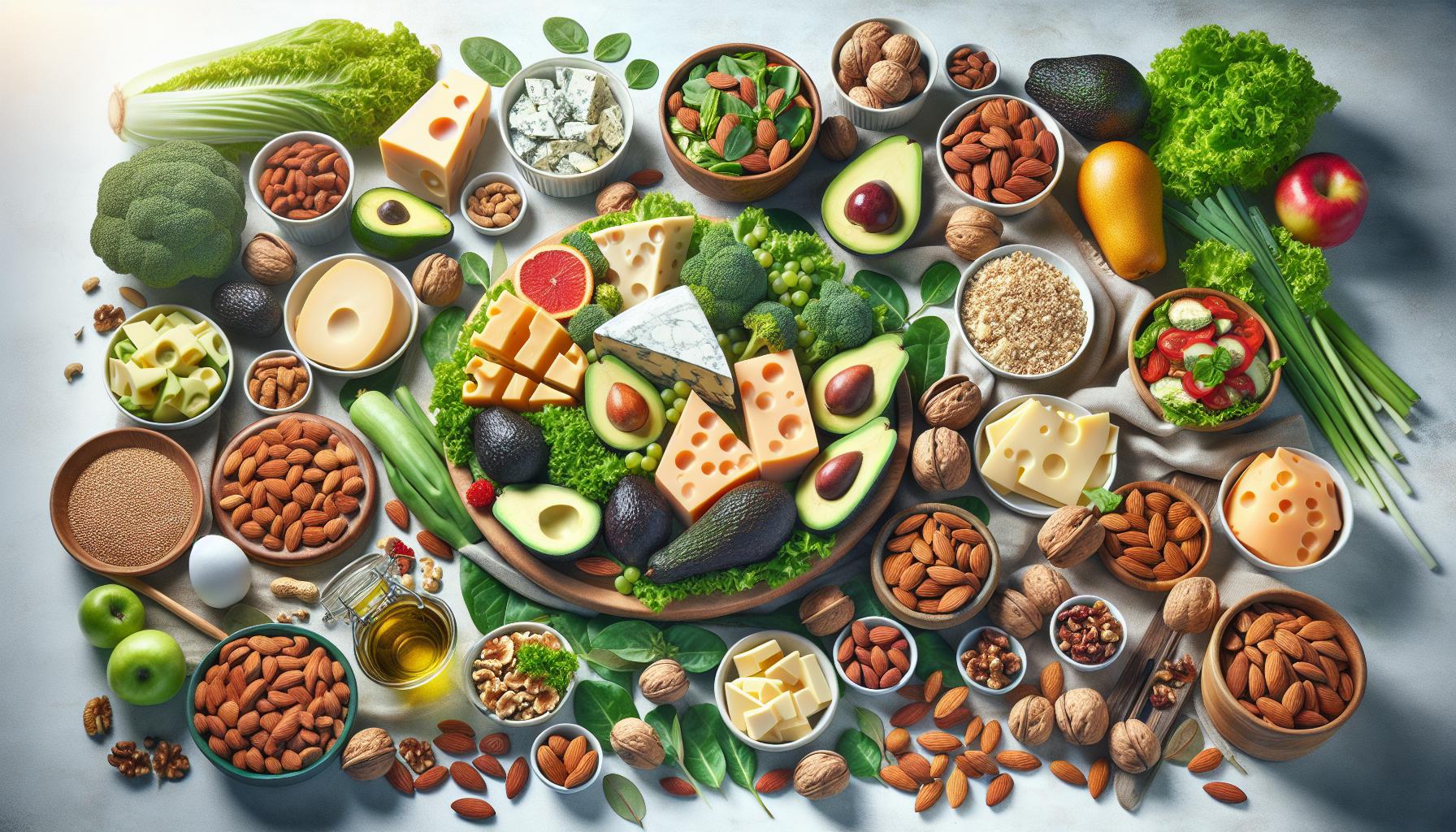Ever wondered how eating more fat could actually help you burn fat? Welcome to the paradoxical world of the ketogenic, or keto, diet. A low-carb, high-fat nutritional plan, the keto diet flips conventional dieting wisdom on its head.
With the keto diet, you’re not just eating differently, you’re fuelling a complete metabolic shift. Your body enters a state known as ketosis, where fat, not carbs, becomes your primary energy source. It’s not just a diet, it’s a lifestyle that offers potential benefits such as weight loss and improved blood sugar control. But like any journey, it’s best to start with a guide. So, buckle up and let’s investigate into the intriguing area of keto.
Key Takeaways
- The ketogenic, or ‘keto’, diet is a low-carbohydrate, high-fat dietary plan. This unique nutritional approach flips conventional dietary wisdom on its head, triggering a metabolic state known as ‘ketosis’ where the body burns fat for energy instead of carbohydrates.
- There are several variations of the ketogenic diet to suit individual lifestyles, preferences, and health goals. These include the standard ketogenic diet, the cyclical keto diet, the targeted keto diet, and the high-protein ketogenic diet.
- In the keto diet, macronutrients- carbohydrates, fats, and proteins, demand meticulous attention. The common macro split in keto aligns with an approximation of 70% fat, 20% protein, and 10% carbohydrates.
- Transitioning into a ketogenic diet may initially lead to temporary symptoms like fatigue and irritability, often referred to as ‘keto flu’. However, once the body adjusts, users often find improved energy, focus and reduced blood sugar levels.
- The keto diet requires careful planning and monitoring but can lead to significant health benefits like reducing inflammation, aiding weight loss and managing neurological disorders.
- Potential risks of the keto diet include nutrient deficiencies due to the limited intake of certain fruits, vegetables and grains, and experiencing the temporary ‘keto flu’ symptoms. As a precaution, it’s important to consult healthcare professionals before starting the ketogenic diet.
Understanding the Keto Diet
What is a Keto Diet?
The ketogenic, or ‘keto’, diet is a low-carbohydrate, high-fat dietary plan. It’s a unique nutritional strategy that flips conventional dietary wisdom on its head. By reducing carbohydrate intake and increasing fat consumption, your body enters a state known as ‘ketosis’, where it primarily burns fat for energy instead of carbohydrates.
Basics of the Keto Diet
Contrary to other diets focused on weight loss, the keto diet is more about macronutrient distribution. The fundamental principle is a diet consisting of around 70% fat, 20% protein and only about 10% carbohydrates. To put this into perspective, a daily intake for an individual following a keto diet could typically include 165 grams of fat, 75 grams of protein, and no more than 40 grams of carbohydrates. The emphasis, as you can see, is heavily on fat and very little on carbs.
How the Keto Diet Works
Your body’s default energy source is glucose, obtained from carbs. But, when the supply of carbs reduces drastically—as it does on a keto diet— your body burns through its glycogen reserves. Later, it’s forced to switch gears and turn to fat as fuel. It begins to produce molecules called ‘ketones‘ from fat, entering a metabolic state named ‘ketosis’. This transition might take a few days and may come with temporary symptoms like fatigue and irritability, often referred to as ‘keto flu‘. But, once acclimated, many find improved energy and focus.
Types of Ketogenic Diets
The term ‘keto diet’ is broad and covers several variations. The most common is the ‘standard ketogenic diet’, which adheres to the strict macronutrient breakdown discussed earlier. Nevertheless, there’re alternative approaches such as the ‘cyclical keto diet’, which includes periods of higher-carb refeeds, and the ‘targeted keto diet’ that allows adding carbs around workouts for athletes. There’s also the ‘high-protein ketogenic diet’, which is similar to the standard one, but includes more protein, approximately 35%. It’s essential to choose the variation that suits your lifestyle, preferences, and health goals.
The Mechanics of Keto Diet

In the journey of understanding the ketogenic diet, it’s essential to grasp its core mechanism. With the focus on fat for fuel, the concept seems to go against traditional dietary instructions. But it’s the intricate mechanics within the body that make the keto diet a remarkably effective approach to healthier living and weight loss.
Reaching Ketosis: How and Why?
Achieving the metabolic state known as ketosis is the primary goal of the keto diet. This state, where your body primarily uses fats rather than carbs for energy, is typically induced by consuming fewer than 50 grams of net carbs a day. Yet, finer tuning such as restricting intake to below 20 grams tends to ensure quicker and more efficient transition into ketosis.
Once carbohydrates intake is significantly reduced and glycogen stores are depleted, your body needs to find an alternative energy source. The liver comes to rescue, breaking down stored fat into ketones, which act as a substitute fuel, specifically for the brain. The shift into using ketones instead of glucose might lead to the “keto flu” – a temporary phase of symptoms like headache and fatigue. But once your body adjusts, you start to reap various benefits such as increased mental clarity and endurance.
Importance of Macros in Keto
In the keto diet, macronutrients- carbohydrates, fats, and proteins, demand your meticulous attention. The common macro split in keto, in the percentage of daily consumption, aligns with an approximation of 70% fat, 20% protein, and 10% carbohydrates.
Fats become your main energy source, thereby aligning with the highest percentage of consumption. Moderate protein intake maintains muscle mass without disturbing ketosis and carbs are kept low to ensure the body stays in this fat-burning state.
Let’s decode this with an example: If you consume 2000 calories a day, about 1400 calories should come from fat, 400 from protein, and 200 from carbs, further tweaking these numbers might be necessary as per your individual requirements.
Keto-friendly Foods and Beverages
In the pursuit of a ketogenic diet, picking the right foods is vital. Almonds, macadamia nuts, and pecans make for good snack choices, with their net carb counts standing at 3g, 2g, and 1g per ounce, respectively. Chia seeds, flaxseeds, and sesame seeds also complement your keto diet with minimal carbs.
When it comes to beverages, water is your best friend. Green tea and coffee sans sugar also align well with keto. Alcoholic beverages, although not entirely prohibited, are best limited due to their typically high sugar content.
Implementing the Keto Diet

Outdoor activities such as hiking, swimming, and jogging are best for maintaining good health. Similarly, to lose weight, you must adopt a well-balanced diet plan. The keto diet could be your game-changer; low in carbohydrates, high in healthy fats, this diet helps your body burn fat more effectively.
Designing a Keto Diet Plan
Designing a keto diet plan involves paying strict attention to macronutrients. Begin with carbohydrates; limit your intake to 20-50 grams per day to help your body achieve a state of ketosis. The absence of carbohydrates forces your body to burn fat for energy which in turn fuels your brain and other vital organs.
Potential sources of healthy fats in a keto diet include fatty fish, cheese, avocados, nuts, and seeds. Aim for these foods to cover approximately 70%-80% of your daily caloric intake. Proteins, on the other hand, also play an essential role in your body and should comprise 10%-20% of your diet. Think lean meats like chicken, beef and fish, and don’t forget plant-based proteins like tofu and tempeh.
When planning meals, consider keto-friendly snacks like almonds and cheddar cheese, avocados stuffed with chicken salad, or a high-energy keto smoothie made with coconut milk, cocoa and avocado. Just remember to keep tracking your carb intake, subtract the fibre intake from the total carb intake for net carbs, and you’re on your way to a healthier, keto-friendly diet.
Physical Performance and the Keto Diet
Physical performance needn’t take a hit when you are on a Keto diet. In the short term, you may notice minor physical performance variances. But, these are temporary and quickly pass as your body adapts to the changes—the transition from burning glucose to burning fats.
Studies done on trained cyclists, for instance, show that aerobic endurance is not compromised at all and their muscle mass remains the same even after being on a ketogenic diet for four weeks. Besides, this switch to burning fats as a primary energy source resulted in consistent weight loss until a healthy, stable weight was attained.
To conclude, although implementing the keto diet requires careful planning and monitoring, it’s an efficient plan that could lead to significant health benefits. From reducing inflammation to aiding weight loss and management, the benefits are numerous. Adhere to the tips shared above, and you’ll be better equipped to start your keto journey.
Health Benefits of the Keto Diet

Entering the area of ketogenic diets, you might already be familiar with their unique ability to utilise fat as a primary energy source. Delving deeper into this powerful dietary approach, numerous health benefits await your discovery.
Weight Loss and Metabolic Advantages
Ketogenic diets continue to earn their reputation through accelerated weight loss potential by maximising fat burning and minimising insulin production. Studies show that following a ketogenic diet resulted in more significant weight loss compared to low-fat diets. This distinct metabolic advantage is a result of the body’s shift into a state of ketosis where it begins to burn fats as its main fuel source instead of carbohydrates.
Less hunger pangs and decreased calorie-counting are part of the package too. Thanks to the satiating capacities of fat-rich foods in the ketogenic diet, you may find yourself feeling full more often and so consuming fewer calories.
Blood Sugar Control and Diabetes Management
Taking a leap further, ketogenic diets have shown immense potential in monitoring blood sugar levels and managing type 2 diabetes. Ketogenic diets often result in lower blood sugar levels, powered by the decreased carbohydrate intake. This form of management can sometimes lead to a decrease in medication requirements for people with type 2 diabetes.
But, it’s essential to consult with healthcare professionals when implementing these changes, particularly when dealing with medication adjustments.
Improved Mental Focus and Energy
Revel in the mental clarity and consistent energy that a ketogenic diet can bring. As the body adapts to a state of ketosis, the brain begins to utilise ketones as a primary energy source instead of glucose. The result? A more steady energy supply and dramatically increased mental performance.
So, if you’ve been feeling foggy or fatigued, adopting a ketogenic diet could help reignite your mental spark, enhancing focus and cognitive abilities.
Potential Benefits for Neurological Diseases
Historically, ketogenic diets have roots in the treatment of neurological disorders, specifically epilepsy in children. With the body and brain fuelled by ketones, neuroprotective effects have been noted, potentially aiding in the management of neurological disorders.
Though the ketogenic diet can offer a wide array of health benefits, it’s crucial to remember everyone’s nutritional needs and responses vary. Always consult a healthcare provider before embarking on changes to your diet, particularly when considering something as drastic as the ketogenic diet. Enjoy your ketogenic journey to optimal health and reap the multifaceted benefits this innovative diet method has to offer.
Potential Risks and Side Effects of the Keto Diet

Embarking on your health journey with the keto diet involves a comprehensive understanding of its potential risks and side effects. Let’s investigate deeper into these aspects.
Common Side Effects: From Keto Flu to Heart Palpitations
Transforming your body into a fat-burning machine via the keto diet can trigger a range of side effects. Initially, as your body adjusts to burning fat for fuel over glucose, you might experience symptoms of the ‘keto flu’. Symptoms often encompass brain fog, muscle aches, constipation, and even a metallic taste in your mouth. Rest assured, these typically subside after a week or so. Alongside these, heart palpitations can emerge with some individuals noticing their heartbeat becoming more noticeable. This too, is typically short-lived, generally improving as carb intake rises.
Nutrient Deficiencies to Watch Out For
Transitioning onto a diet that severely restricts carbohydrates poses another potential pitfall: nutrient deficiencies. A keto diet may limit your consumption of nutrient-packed fruits, vegetables, and whole grains, potentially leading to deficiencies in key vitamins and minerals vital for your body’s optimal functioning. This necessitates careful planning of your meals and, if needed, suitable supplementation to fill in the nutritional gaps.
Understanding the ‘Keto Flu’
Let’s step back a notch. ‘Keto flu’ is a term coined to describe the cluster of symptoms some people experience in the initial phase of the ketogenic diet. Remember, it’s not an illness but signifies your body adjusting to the significant change in its energy source. Symptoms can vary from person to person and may include fatigue, nausea, headaches, and difficulty focusing, alternatively known as ‘brain fog’.
Addressing Common Misconceptions
In the world saturated with diets and weight loss advice, numerous misconceptions surround the keto diet. A common myth is that consuming large amounts of fat leads to high cholesterol levels. But, research suggests that a low-carb diet, like keto, can actually improve levels of HDL (‘good’ cholesterol). Another misconception posits the keto diet as a magic pill for weight loss. While the diet does typically result in initial weight loss — mostly due to water weight — long-term success depends on your ability to stick to the diet and incorporate it alongside other healthy behaviours, such as regular exercise.
In all, remember to consult healthcare professionals before starting the ketogenic diet, and monitor your nutritional intake and general health carefully during the process. It’s your body, your journey, and armed with the full knowledge, you’re set for the ride.
The Keto Diet: Is it Right For You?

Before diving headfirst into the world of ketogenic diet, one must comprehend all its aspects, dimensions and implications. From nutritional benefits to potential drawbacks, considering every factor matters. This section will illuminate the contradictions and precautions associated with the ketogenic diet, and guide you on how to make the most of your keto journey.
Contradictions and Precautions
The ketogenic diet involves mostly fats, moderate protein and a small amount of carbs, as per bulletproof(.com) diet guidelines. The low carbohydrate intake – ideally less than 20 grams of net carbs per day, induces a metabolic state known as “ketosis”. Whilst ketosis is a natural process and offers health benefits such as healthy weight loss and improved metabolic health, it isn’t a solution for everyone.
People with type 1 diabetes, for instance, should not follow this diet. Such individuals might have difficulty regulating ketone production and, so, are at risk of ketoacidosis, a serious complication.
Potential risks might also encompass nutrient deficiencies, especially when severely restricting carbohydrates. So, such restriction might mean avoiding certain fruits, vegetables, and grains, which are responsible for supplying essential vitamins, minerals, and fibre. The long-term effects of such a deficiency could be detrimental for your overall health.
You might experience “keto flu” in the initial stages – a temporary condition marked by headache, fatigue, nausea, and irritability. This comes as a result of the brain transitioning from glucose to ketones as its primary fuel source.
Making the Most of Your Keto Journey
Embracing the ketogenic diet doesn’t equate to depriving yourself. It’s about understanding what your body requires and delivering exactly that. This idea necessitates a deliberate, well-informed approach. For instance, if you’re initiate to keto, you must acquaint yourself with various types of keto diets – standard diet, cyclical keto, and dirty keto – before making a decision about which one suits your requirements.
A successful keto journey involves regular monitoring of your nutritional intake. It proceeds hand-in-hand with a balanced diet, where the inclusion of nutrient-dense, low-carb foods is important. You might also consider supplementing your diet with essential vitamins and minerals that might be deficient due to restriction of certain foods.
In the end, everyone’s experience with the ketogenic diet will be distinct. Accept that you’ll need to experiment, over the course of your journey, with different foods to figure out what works best for your body. This personalised approach to dieting may not only help you reach your health goals but also keep you motivated throughout the journey.
Remember, it’s not a race. It’s a journey towards healthier living. Take your time to transition, adapt, and most importantly, enjoy the process.
Conclusion: Evaluating the Pros and Cons of the Keto Diet
So, you’ve got the lowdown on the ketogenic diet. It’s clear this diet isn’t a one-size-fits-all solution. It’s about finding what works best for your body and lifestyle. You’ve learned the importance of understanding the mechanics, benefits, and potential risks associated with this diet. It’s not just about slashing carbs; it’s about a balanced and monitored nutritional intake.
Remember, it’s essential to consult healthcare professionals before embarking on your keto journey. They’ll help you navigate potential pitfalls, like nutrient deficiencies or the dreaded ‘keto flu’. And if you’re living with type 1 diabetes, tread with extra caution.
The ketogenic diet can be a powerful tool for healthier living. But it requires careful planning, understanding, and a personalised approach. With this guide in your arsenal, you’re well-equipped to make an well-informed choice about whether the keto diet is right for you.

